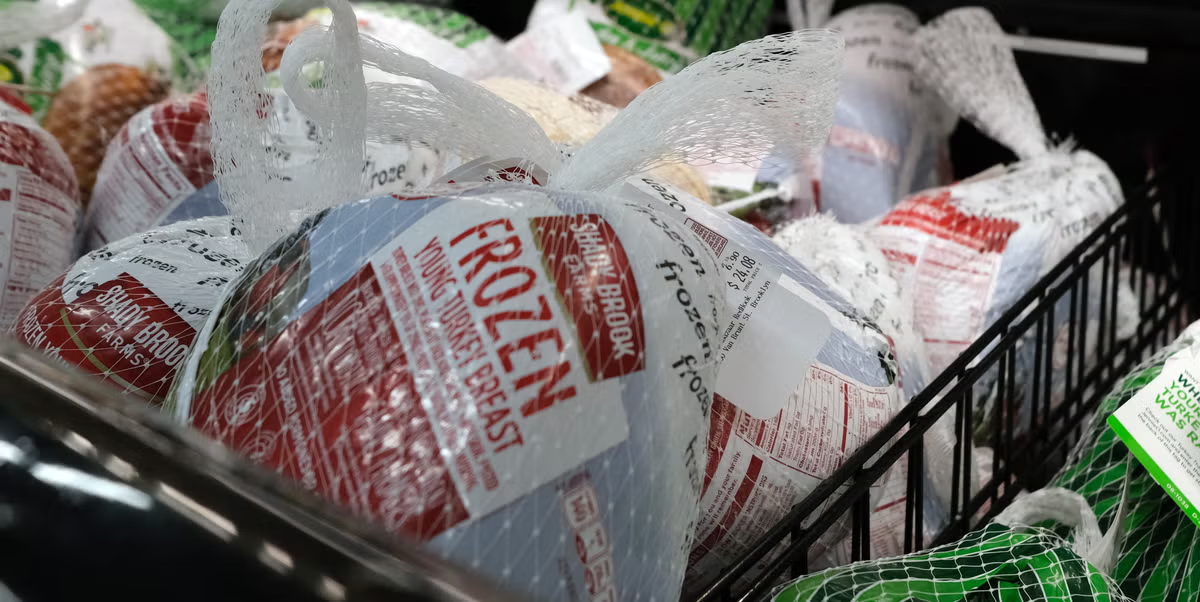How To Avoid Salmonella When Thawing A Frozen Turkey This Thanksgiving

- Thanksgiving turkeys are commonly purchased frozen and have to be thawed before roasting.
- To avoid spreading food-borne illness, health experts recommend defrosting a frozen turkey in the refrigerator.
- Other ways to avoid contamination include placing the bird on a tray and keeping it away from other ingredients.
Thanksgiving hosts face a lot of pressure, especially when it comes to executing an elaborate holiday meal. Cooking a feast from start to finish, from apps to desserts, takes days of preparation, and it all starts with the turkey.
You might know that the centerpiece of any traditional Thanksgiving dinner needs hours in the oven and at least a day of brining, but don’t forget the time it takes to defrost before then, too. Though fresh turkeys are available, frozen ones are the most popular picks at the grocery store, thanks to their lower price and longer shelf life. In the likely event that you buy a frozen bird this year, you’ll need to know how to work with it.
Making sure it tastes good is one thing, but ensuring that it’s safe to eat is something else entirely. Just like with chicken, turkey runs the risk of spreading salmonella and other harmful bacteria. It’s important to proceed with caution at every stage of the process, including thawing, to avoid making your guests sick.
We’re breaking down all of the safety considerations you should keep in mind with thawing a frozen turkey to avoid the spread of any unwanted germs.
Keep It In The Fridge
The USDA says it’s also safe to defrost turkey in cold water, but in our opinion? It’s not worth the hassle. The best bet is to use the refrigerator, where the bird can gradually come up to the proper temperature with less risk of bacterial growth. What you should never do: thaw it on the counter, in the garage, or with warm water.
These environments are less controlled and can expose the turkey to the temperature danger zone (between 40°F and 140°F), which is the ideal environment for germs to grow. Even if the center of the turkey is still frozen, the thawed exterior can become a hotbed for salmonella by the time you’re ready to roast.
Use A Tray
Roasted turkey drippings are great for making gravy. But raw turkey juice dripping all over your fridge? Not so much. Even shrink-wrapped birds can leak, so you should always store your turkey on a baking sheet or roasting pan while it thaws.
Kurgu128//Getty Images
Make Plenty Of Space
We know you’re probably keeping a lot of other ingredients in your fridge, so it can be hard to set aside extra room for the turkey. That said, it’s a step worth doing. Giving your turkey plenty of personal space minimizes the risk of rubbing raw meat against your other ingredients.
In the event that your turkey does make contact with another ingredient, here’s what to know: If you’re cooking that contaminated ingredient, the chances of you contracting a foodborne illness aren’t particularly high, but if any of those foods are served raw, like in a salad, they should be tossed.
Set Aside Enough Time
Turkeys are big, so it will take a considerable amount of time before they thaw all the way through. The experts at Butterball say that you should allocate a day for every four pounds of turkey if you’re keeping it in the fridge. That means if you’re working with a 16-pound bird, you need to set aside four days just for defrosting. And once you’re fully thawed, Butterball says your turkey will stay safe in the fridge for up to four days.
And on top of that, the best-tasting turkeys are the ones that have been brined. And if your frozen bird didn’t come pre-seasoned, you’ll have to set aside at least another day or two to make sure it’s flavorful from the inside out. (Want some guidance? Check out our brining guide.)
Mike Kemp//Getty Images
Keep Things Clean
It’s extremely important to keep things clean while you’re handling a turkey. The most common way salmonella is spread is through cross-contamination caused by poor hygiene.
So wash those hands (including under your fingernails!) and/or opt for gloves to be extra safe. Make sure you wipe down every surface well before and after working with your bird, preferably with a cleanser that has antimicrobial properties.
Above all, don’t stress! Americans cook around 46 MILLION turkeys every Thanksgiving, so you’re not alone in your turkey-roasting journey. Follow the above tips to guarantee yours turns out safe to eat AND delicious.





